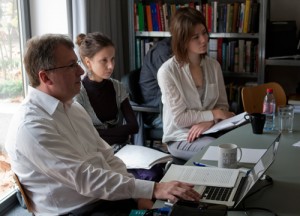
If a painting is presented to two people, each of them would probably see something different in it. They might even disagree about what they see to the point of drawing daggers. Art involves the viewer in a very unique way and the experience of looking at something and feeling something is individual. As we study Renaissance art this term, we look at how objective or subjective this art is, by analyzing the different methods of drawing used by artists such as Leonardo da Vinci over the course of history.
ECLA invited Dr. Frank Fehrenbach, who is currently living in Italy, on sabbatical leave from Harvard University, to give a lecture on basic questions related to Renaissance art. His lecture focused on various aspects of Leonardo’s art.
He started his lecture by describing the 16th century art period as a “revolution within a revolution.” He went on to describe that the revolution of three-dimensional art had started during the 13th and 14th centuries – the early Renaissance period during which artists began depicting images in a more human and real way. The 16th century was a step further in the direction of naturalism and realism.
The beauty of 16th century art lay in the way it was painted to involve the viewer in an extremely inclusive experience. It defined the methodology of art and influenced later art. We would now take techniques of perspective as a given in modern art, in the same the way we take the solar system for granted, but at the time when this technique was discovered, it was revolutionary.
Leonardo, as Dr. Fehrenbach put it, changed the meaning of reality and ‘natural’. He started his study of art from the inside of the object and went on to paint the outside as well. Dr. Fehrenbech showed the drawings Leonardo had done in preparation for his work and explained how those drawings showed the inner workings of his mind. He showed us how the drawing clearly dealt with each and every minute detail of the work with the intention of showing the very way the actual thing would be. In as many words, Leonardo made people see the reality for what it was and the way he viewed it. In his work, there is a play with the idea of objectivity and subjectivity.
Dr. Fehrenbech also very clearly laid out the autobiography of Leonardo and linked it to his process of creating works of art. It was a surprise for me to know that as a child Leonardo dropped out of high school, which would never allow him to learn Latin, Greek, and Mathematics. Yet, his genius was indubitable when it came to creating highly technical equipment for war or for the city.
He also identified himself as an engineer and not as an artist in a letter written to a ruler of that time, when offering his services to him. Leonardo produced unlimited works of art during a very short period of time, but he embraced his artistic side in the most difficult and psychologically depressing periods of his life. When he struggled most with his work, he produced the best art known to mankind.
Dr. Fehrenbach’s lecture highlighted some of the most important aspects of Leonardo’s art techniques and the message to take home was: what exactly is reality and nature in Leonardo da Vinci’s view?
